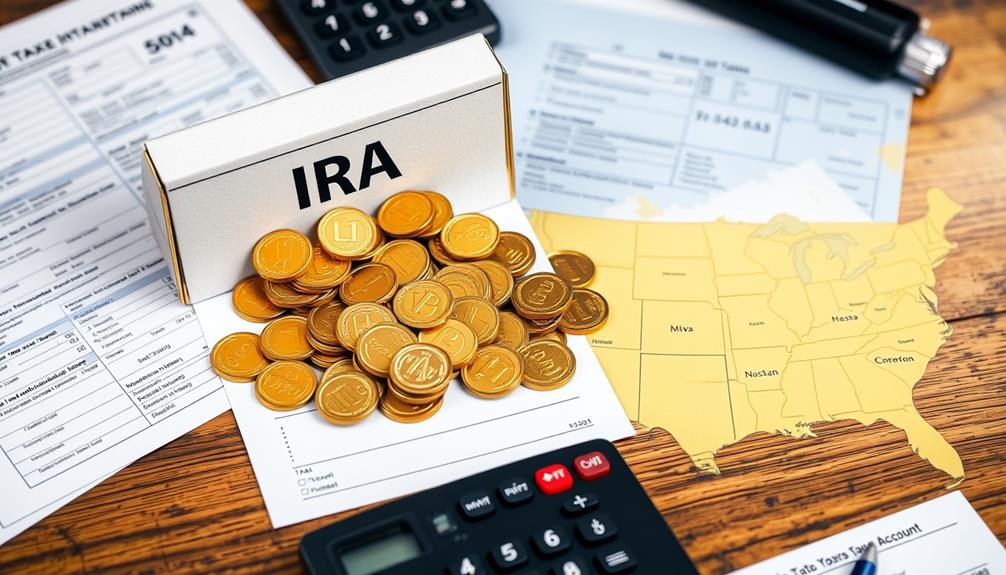Consider incorporating a Self-Directed IRA (SDIRA) into your retirement investment plan to include real estate investments, offering autonomy and versatility. Start by selecting a custodian experienced in SDIRAs. Fund your account by transferring current retirement funds or rolling over from a 401(k). Keep in mind that all property expenses and rental income need to be directed through your IRA. Adhere to IRS guidelines, including refraining from personal usage of the properties. Through careful planning and effective oversight, you can improve your investment portfolio. There is a wealth of information available to help you maximize your real estate investments.
Key Takeaways
- Set up a Self-Directed IRA (SDIRA) with a specialized custodian to invest in real estate assets directly.
- Ensure all property titles are held in the name of the SDIRA to comply with IRS regulations.
- Generate income and pay expenses exclusively through the SDIRA to maintain tax advantages and compliance.
- Conduct thorough due diligence on properties to assess market trends and investment potential before purchase.
- Be aware of prohibited transactions and ensure clear separation between personal use and IRA investments to avoid penalties.
Understanding Self-Directed IRAs

A Self-Directed IRA (SDIRA) offers you the freedom to invest in a wider array of assets, particularly real estate, beyond the typical stocks and bonds.
With an SDIRA, you gain direct ownership of investment properties, allowing you to actively manage and control your real estate investments. This hands-on approach helps you build a diverse retirement portfolio that meets your financial goals.
Additionally, incorporating precious metals into your investment strategy can provide a hedge against inflation and market volatility, similar to the benefits of IRA Rollover to Gold.
To maintain tax advantages, it's vital that all income and expenses from these investments flow through your SDIRA. This guarantees you benefit from tax-deferred growth, potentially boosting your retirement savings.
Remember, all property titles must be held in the name of the SDIRA, not in your personal name. This compliance with IRS regulations is essential to avoid penalties.
Additionally, you need to be aware of the rules surrounding disqualified persons, which prohibit personal use of investment properties.
Benefits of Real Estate Investments

Investing in real estate through a Self-Directed IRA (SDIRA) offers numerous advantages that can greatly enhance your retirement savings strategy. One key benefit is the tax-deferred growth in a Traditional IRA or tax-free growth in a Roth IRA. This means your investment can grow markedly without immediate tax implications, maximizing your long-term retirement potential.
Additionally, much like Gold IRAs, real estate investments also promote diversification in your portfolio, reducing your exposure to market volatility typically associated with stocks and bonds. By including rental properties, you can generate consistent cash flow, which can be reinvested into your IRA for compounded growth.
In addition, real estate has a history of appreciation, often outperforming other asset classes. This provides you with the potential for considerable gains upon sale or inheritance.
Moreover, properties held in your self-directed IRA enjoy creditor protection, adding an extra layer of security to your retirement savings. By incorporating real estate into your investment strategy, you not only enhance your cash flow but also position yourself for a more resilient financial future.
Types of Real Estate Options

When it comes to Real Estate IRAs, you've got several exciting options to evaluate. Investing in real estate can provide stable cash flow and potential tax advantages, making it an appealing addition to your retirement portfolio.
You can invest in residential properties, commercial ventures, or even land and mortgage notes. Each type offers unique opportunities for growth and returns, so let's explore what fits your investment strategy best.
Additionally, it's important to assess how diversification of retirement portfolio can enhance your long-term financial security.
Residential Investment Opportunities
Exploring residential investment opportunities within a Real Estate IRA opens up a range of options, from single-family homes to multi-family properties and apartments. These investments can generate diverse rental income streams, enhancing your retirement savings. You might choose strategies like long-term rentals for consistent cash flow or fix-and-flip projects for quick returns through renovations.
However, it's essential to remember that properties held in your Real Estate IRA must strictly be for investment purposes, ensuring compliance with IRS regulations. This means personal use of the properties is prohibited.
Here's a quick comparison of different residential investment options:
| Property Type | Benefits |
|---|---|
| Single-Family Homes | Easy management, stable demand |
| Multi-Family Units | Multiple rental income sources |
| Apartments | Economies of scale, higher cash flow |
| Fix-and-Flip | Quick profits through renovation |
| Long-Term Rentals | Steady rental income, appreciation potential |
Investing in residential real estate may also serve as a hedge against inflation, as property values tend to appreciate over time. Plus, rental income is tax-deferred in a Traditional IRA or tax-free in a Roth IRA, maximizing your growth potential.
Commercial Property Ventures
Commercial property ventures offer a wealth of investment opportunities, ranging from office buildings and retail spaces to warehouses and industrial facilities.
These commercial properties can be an excellent addition to your retirement investment strategy, especially through real estate IRAs. Investing in tangible assets like commercial real estate can provide a hedge against inflation and increase overall portfolio resilience, similar to trusted precious metal investments.
Here are four options to examine:
- Office Buildings: Long lease terms provide stable cash flow, making them attractive for investors.
- Retail Spaces: With the right location, retail properties can generate significant appreciation over time.
- Warehouses: The rise in e-commerce has increased demand for logistics and storage, creating consistent revenue streams.
- Industrial Facilities: These properties often yield higher returns, especially in growing urban areas.
Investing in commercial real estate through self-directed IRAs allows you to diversify your portfolio effectively.
Additionally, Real Estate Investment Trusts (REITs) focused on commercial properties offer a more liquid option for those who prefer not to manage physical properties.
Land and Notes
Investing in land and mortgage notes through a Real Estate IRA opens up unique avenues for portfolio diversification and growth. You can choose between improved land, which comes with utilities and infrastructure, or raw land, which may appreciate as development occurs. Both options offer passive investment opportunities with minimal upkeep and significant potential for appreciation over time.
| Type of Investment | Key Benefits |
|---|---|
| Improved Land | Greater development potential, ideal for long-term gains |
| Raw Land | Low-maintenance, enhances portfolio diversification |
| Mortgage Notes | Generates income while avoiding direct property management |
Rules for Real Estate IRAs

When investing in a Real Estate IRA, you need to understand the rules that govern these accounts.
There are strict prohibitions on personal use and transactions involving disqualified persons, so it's essential to stay compliant with IRS regulations.
Understanding the potential benefits of diversifying your retirement savings through investment comparisons can help you make informed decisions.
Failing to follow these guidelines can lead to significant penalties, including disqualification of your IRA.
Prohibited Transactions Explained
Understanding prohibited transactions is vital for anyone managing a Real Estate IRA. These transactions can jeopardize your retirement investment and lead to hefty penalties. It's important to recognize what constitutes a prohibited transaction under IRS regulations.
Here are four key points to keep in mind:
- Personal Use: You and your family members can't use the IRA-owned properties for personal purposes. Doing so can disqualify your IRA. It's essential to maintain a clear separation between personal and investment activities, as common financial terms can greatly impact your understanding of compliance.
- Disqualified Persons: Selling or leasing property to disqualified persons, including yourself or relatives, is strictly forbidden.
- Self-Dealing: Engaging in self-dealing, such as buying property from a family member or receiving compensation for property-related services, is a clear violation.
- Income and Expenses: All income generated from IRA-owned properties must return to the IRA account. Additionally, expenses must be paid from IRA funds to comply with IRS rules.
To maintain compliance and avoid penalties, verify that all transactions are conducted at arm's length and that you have a thorough understanding of disqualified persons.
Remaining vigilant about these prohibited transactions will help secure your investment and guarantee your IRA remains intact.
Personal Use Restrictions
Personal use restrictions are a fundamental aspect of managing a Real Estate IRA, guaranteeing that the properties held within your Self-Directed IRA (SDIRA) remain purely investment assets. You can't live in or use any IRA-owned property for personal purposes.
The IRS defines disqualified persons, including you, your family members, and certain business associates, who mustn't benefit from these properties. Understanding financial implications in divorce can also provide valuable insights when considering investments like real estate in your retirement strategy.
Engaging in prohibited transactions, like selling or leasing the property to disqualified persons, can lead to severe tax consequences, including disqualification of your IRA. It's essential that your property generates income, reinforcing its status as an investment asset and adhering to IRS regulations.
If you violate personal use restrictions, the IRS may deem the property a distribution, resulting in immediate tax liabilities and potential penalties.
To avoid these pitfalls, always verify that your Real Estate IRA properties are treated strictly as investments, free from personal benefit. By following these guidelines, you can maintain compliance and protect your retirement savings effectively.
Compliance With IRS Regulations
Steering through the complexities of compliance with IRS regulations is essential for anyone managing a Real Estate IRA. Adhering to these rules guarantees your self-directed IRA remains in good standing and avoids penalties.
Understanding how to avoid Gold IRA scams can also be beneficial as it highlights the importance of due diligence in any investment, including real estate. Here are key compliance points to remember:
- Investment Properties: All properties must be titled in the name of the IRA, keeping personal and IRA assets separate.
- Property Expenses: Your IRA must pay for all property expenses, including maintenance and taxes, directly from IRA funds.
- Disqualified Persons: Avoid transactions with disqualified persons, such as family members or certain service providers, to prevent violations.
- Income Generation: Properties owned by the IRA must generate income, with all rental income flowing back into the IRA to maintain compliance.
Engaging in self-dealing—like using the property for personal benefit—can lead to severe tax penalties and potentially disqualify your IRA.
Setting Up Your Self-Directed IRA

To kickstart your journey into real estate investments through a Self-Directed IRA (SDIRA), the first step is choosing a custodian who specializes in managing these accounts. A trust company experienced in SDIRAs will guarantee your transactions comply with IRS regulations.
As a real estate investor, you'll want to fund your SDIRA by transferring funds from an existing IRA, rolling over from a 401(k), or making cash contributions—all while adhering to IRS contribution limits.
When you purchase the property, it must be titled in the name of the IRA, not in your personal name. This guarantees that all income and expenses, including maintenance costs, flow through the IRA funds.
The transaction documents should clearly indicate the IRA as the buyer, formatted as "The Entrust Group, Inc. FBO [Client Name] Account# [Client Number]."
Managing Investments Within an IRA

Managing real estate investments within a Self-Directed IRA (SDIRA) requires careful attention to detail and compliance with IRS regulations.
You'll need to guarantee that all income generated from your investments flows directly into the SDIRA, allowing for tax-deferred growth. Background checks, especially for tenants, are vital in safeguarding your investment and guaranteeing the safety of your property, as they help identify potential red flags in a candidate's history background check importance.
Here are some key considerations:
- Property-related expenses: Always pay expenses like maintenance and repairs from the SDIRA. Never use personal funds for IRA-owned properties.
- Legal documents: Make sure all legal documents, including leases and insurance policies, are titled in the name of the SDIRA. This maintains clear ownership and compliance with IRS regulations.
- Property manager: Consider hiring a property manager to handle daily operations. This can enhance operational efficiency and guarantee adherence to regulations.
- Unrelated business income tax: If you finance property purchases with debt, be aware of unrelated debt-financed income (UDFI) and potential unrelated business income tax (UBIT) on profits exceeding $1,000.
Challenges of Real Estate IRAs

Investing in real estate through an IRA presents unique challenges that can complicate your financial strategy. One of the most significant hurdles is the illiquid nature of real estate. Unlike stocks, selling property can take time and involves maneuvering through complex processes, including compliance checks with custodians.
Additionally, fluctuations in the real estate market can affect property values, exposing you to risks that traditional investments might not face. You also have to take into account that all property-related expenses must come from the IRA, which can quickly deplete your funds and hinder long-term growth, especially if you encounter unexpected repairs.
Furthermore, you must remain vigilant about IRS regulations governing self-directed IRAs. Non-compliance can lead to severe penalties, including disqualification of the IRA and immediate tax liabilities.
| Challenge | Impact on Investment Decisions |
|---|---|
| Illiquidity | Hard to convert assets to cash |
| Market Fluctuations | Risk of decreased property values |
| Compliance Checks | Lengthy and complex processes |
| Unexpected Expenses | Depletes IRA funds |
Understanding these challenges is essential for making informed investment decisions in your Real Estate IRA.
Financial Considerations for Investors

When diving into Real Estate IRAs, understanding the financial considerations is essential for your success. With the growing demand for transparency in private equity and investment strategies, it's important to be aware of how these factors can impact your real estate investments. Here are four key points to keep in mind:
- Cash Requirements: Properties often require substantial cash payments, making it challenging to maintain liquidity within your IRA. Mortgages can be difficult to obtain, so you'll need to plan accordingly.
- Covering Expenses: All expenses related to your investment—including repairs and maintenance—must be paid from your IRA funds. This can quickly deplete your assets and impact your long-term growth potential, especially in a market where sector performance metrics are increasingly important for investors.
- UBIT Awareness: If you finance your property with debt, the revenues generated may be subject to Unrelated Business Taxable Income (UBTI). Careful tax planning is important to avoid unexpected liabilities.
- Financial Buffer: Annual contribution limits for IRAs can restrict your ability to cover unexpected costs. It's essential to maintain a financial buffer within the account to manage potential high maintenance expenses and avoid penalties for insufficient funds.
Strategies for Successful Investments

Maneuvering the complexities of Real Estate IRAs requires a strategic approach to assure successful investments. Start by utilizing a self-directed IRA (SDIRA) to gain full ownership and control over your real estate portfolio.
Conduct thorough due diligence on potential properties, analyzing location, market trends, and financial projections to confirm your choices align with your retirement goals.
Diversification is key. Consider investing in various property types—residential, commercial, and raw land—to mitigate risks and enhance potential returns. This variety helps cushion your portfolio against market fluctuations.
Partnering with reputable real estate agents and financial advisors is essential. They can help you develop a detailed investment strategy tailored to your risk tolerance and retirement objectives.
Don't forget to regularly review and adjust your strategy based on market conditions and property performance.
Frequently Asked Questions
Should You Add Residential Real Estate to Your Retirement Portfolio?
You should consider adding residential real estate to your retirement portfolio. It offers diversification, potential appreciation, and consistent cash flow. Just make certain you comply with regulations and think about market conditions before investing.
Can I Put Property in My Ira?
Yes, you can put property in your IRA by using a Self-Directed IRA. Just remember, the property must be solely for investment, and it can't be personally used or owned directly by you.
How Can Real Property Contribute to Your Retirement Income?
Real property can boost your retirement income by generating rental income, appreciating over time, and providing a hedge against inflation. It diversifies your portfolio, reducing reliance on stock market fluctuations and enhancing financial stability.
Can I Transfer My IRA to an Investment Property?
Can you really transfer your IRA to invest in property? Absolutely! You can roll over your existing IRA funds into a Self-Directed IRA, allowing you to explore diverse real estate opportunities while enjoying tax advantages.
Conclusion
Incorporating real estate into your retirement strategy can be a game-changer. For instance, if you invest in a rental property through a self-directed IRA, you could generate passive income while your investment appreciates over time. Just remember to follow the rules carefully and manage your properties wisely. By diversifying your retirement portfolio with real estate, you're not just securing your future—you're actively growing your wealth. It's time to take control and make your retirement dreams a reality!
Helen brings a wealth of experience in investment strategy and a deep passion for helping individuals achieve their retirement goals. With a keen understanding of market dynamics, Helen has been instrumental in shaping the vision and direction of Gold IRA Markets. She specializes in creating innovative solutions that align with our clients’ long-term investment objectives.










